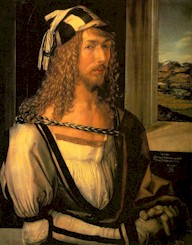
I. Etchings 1 - 6
II. Etchings
7 - 12
III. Etchings
13 - 18
IV. Etchings
19 - 24
V. Etchings
25 - 30
VI. Etchings
31 - 36
VII.Etchings
37 - 42
 |
I. Etchings 1 - 6 |
||
| Self- Portrait. 1498 El Prado. Madrid |
Albert Durer was born in the imperial city of Nuremberg, the 21rst of May , in 1471, in family of Hungarian goldsmiths. In 1494 in married Agnes Frey. I died in the same city, the 6th April 1528. Durer spent all his life in Nuremberg, only leaving it to make three long journeys : in 1494 and from 1505 to 1507 to Italy, and from 1520 to 1521 to Antwerp and the Netherlands.
The vast work of the author includes painting and engraving and even the writing of theoretical monograph related to the problems of perspective i.e."Underweysung de Messung ". The artist was trained in the last third of the fifteen century in the surroundings strongly influenced by the Flemish school and the German gothic tradition Already in the beginning of the XVI century Durer made his second trip to Italy and came in contact with Bellini, Mantegna and Venetian school assimilating the artistic and theoretical fundamentals of the Italian Renaissance.
Our exhibition of engravings includes the three"master prints": " Melancholy"[1], "Saint Jerome in his study "[2] and "The Knight, Death and the Devil"[3] and the series of "The Revelation of S.John"(Apocalypse) [27-40] executed between 1496 and 1498 His great capacity for creating images that can be seen in this website help us to understand the comparison his contemporaries made between his work and that of Apeles the classic Grecian artist. The recognition of his mastery at creating illusion reached its zenith after publishing "Underweysung der Messung"(1525)[41],in which the artist made a scientific approach to the problem of artistic representation. This sense of composition runs through the selected images. At the same time the realistic detail is shown in thorough description it is combined with objects of high symbolic significance The engravings which contains holy scenes are set in peasant surroundings following the impulse of the Reformation to bring the Bible to common people.
Durer executed " Melancholy"[1] the year his mother died, and according to Erwin Panovski represents the "spiritual self-portrait. According to Durer, the artist's genius casts him to the depths of melancholy (Greek melan=black, cholé=bile). "St. Jerome" [2], translator of the Vulgate Bible, is one of the figures most often portrayed in the artist's paintings and engravings. The composition as much as the perspective or the play of light and shadow stand out in this etching.Traditionally the figure of the Saint was represented in the desert, while in this etching he is placed in a room in front of a window, which is the source of light sitting at a simple wooden table. The animals and the skull blend naturally with the furniture of the room. Our third master etching,"The Knight"[2] is constructed on a double diagonal cross formed by the rider and the cliff ,which is the prolongation of the sword. Between the "strength" of the castle and the loyalty of the dog, watchful in the presence of the devil (on the right) and death holding an hourglass (on the left), the Christian knight rides towards the necessity of contrition (Durer). The series of the "The Revelation of S.John" executed between 1496-98 retains in part the gothic influence in the motley visual narrative structure. The complexity is not only limited to the composition (sky, stars, landscapes) it also extends to the fore shortening and the placement of the objects caught up in the visual narrative.
Screensaver (1 Mb)
Durerus courtesy www.eweil.com